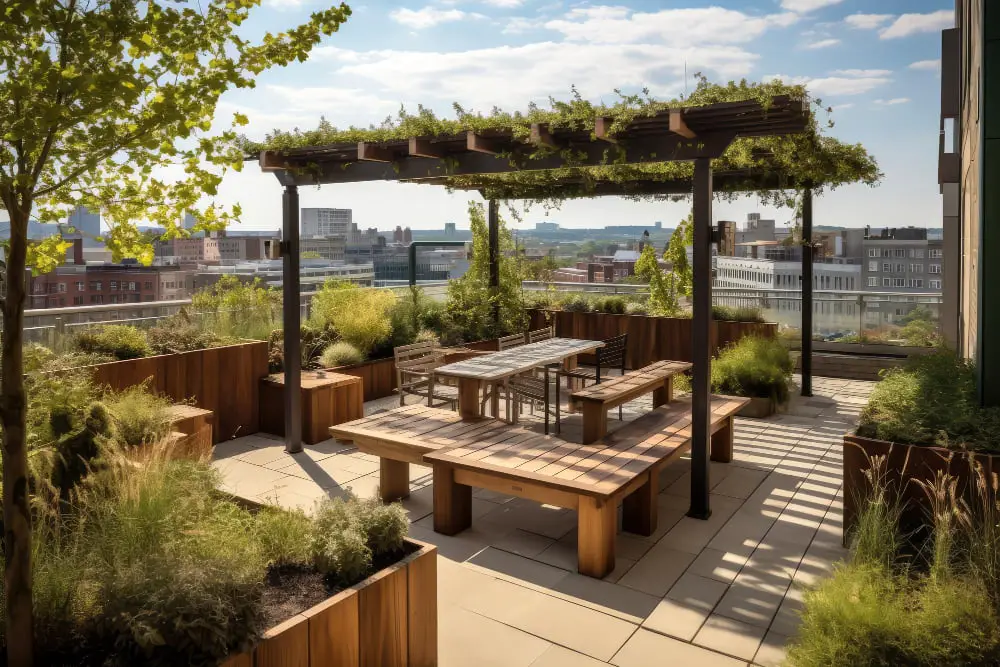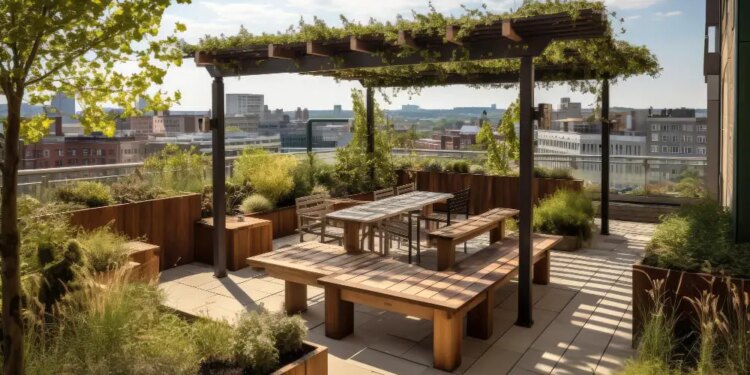"Designing a Rooftop Garden on a Flat Roof House Plan” sets the stage for this enthralling narrative, offering readers a glimpse into a story that is rich in detail with casual formal language style and brimming with originality from the outset.

"This article delves into the art of creating a vibrant rooftop garden on a flat roof house plan, exploring the intricacies of design, installation, and maintenance to transform your rooftop into a green oasis above the cityscape."
Introduction to Rooftop Gardens
A rooftop garden is a green space created on the top of a building, typically a flat roof, where plants, flowers, and even trees can be cultivated. These gardens can vary in size, from small containers to extensive landscapes, and provide numerous benefits to both the environment and the building's occupants.
Benefits of Having a Rooftop Garden
- Improved Air Quality: Rooftop gardens help reduce pollution by absorbing carbon dioxide and releasing oxygen, making the air cleaner and healthier to breathe.
- Energy Efficiency: The vegetation on a rooftop garden can act as natural insulation, reducing the need for heating and cooling systems, thus lowering energy consumption.
- Stormwater Management: Green roofs can absorb rainwater, reducing runoff and the risk of flooding in urban areas.
- Biodiversity Support: Rooftop gardens provide habitat for birds, insects, and other wildlife, promoting urban biodiversity.
Environmental Impact of Rooftop Gardens
Rooftop gardens have a positive environmental impact by mitigating the urban heat island effect, where cities become significantly warmer than rural areas due to human activities and structures. The vegetation in rooftop gardens helps cool the surrounding area and reduce energy consumption, making them a sustainable choice for urban development.
Planning and Preparation
When designing a rooftop garden on a flat roof house plan, it is crucial to assess the structural integrity of the flat roof. This will ensure that the roof can support the weight of the garden, plants, and any additional features you may want to add.
It is recommended to consult with a structural engineer to determine the load capacity of the roof and make any necessary reinforcements.
Choosing the Right Plants
Selecting the right plants for your rooftop garden is essential for its success. Opt for lightweight plants that do not have invasive root systems to prevent damage to the roof membrane. Drought-resistant plants are also ideal as they require less water and maintenance.
Consider the amount of sunlight your rooftop receives and choose plants that thrive in those conditions.
Importance of Proper Drainage
Proper drainage is key to the longevity of your rooftop garden. Without adequate drainage systems, excess water can accumulate on the roof, causing structural damage and water leakage. Install drainage pipes, gutters, and a waterproof membrane to ensure that water flows away from the roof efficiently.
Regularly check and maintain these systems to prevent any issues in the future.
Design Considerations
When it comes to designing a rooftop garden on a flat roof house plan, there are several important considerations to keep in mind to create a functional and aesthetically pleasing outdoor space.
Different Design Styles
There are various design styles that can be adapted to rooftop gardens, depending on the overall aesthetic of the house and the preferences of the homeowner. Some popular design styles include:
- Modern and minimalist: Clean lines, simple plant arrangements, and sleek furniture characterize this style.
- Urban oasis: Incorporating elements like water features, cozy seating areas, and greenery to create a peaceful retreat in the city.
- Botanical paradise: Focusing on lush plants, colorful flowers, and a variety of textures to create a vibrant garden atmosphere.
Role of Furniture and Decor
Furniture and decor play a crucial role in enhancing the rooftop garden experience. By carefully selecting outdoor furniture that is both functional and stylish, you can create inviting seating areas for relaxation or dining. Decor elements such as outdoor rugs, throw pillows, and lighting can add personality and charm to the space, making it feel like an extension of the indoor living area.
Incorporating Sustainable Elements
Integrating sustainable elements into the design of a rooftop garden is not only environmentally friendly but also adds an extra layer of interest to the space. Consider incorporating features such as:
- Water-saving irrigation systems
- Native plants that require less water and maintenance
- Solar-powered lighting or water features
- Composting bins for organic waste
Installation and Maintenance
Installing a rooftop garden on a flat roof house plan requires careful planning and execution to ensure success. Once the design is finalized, it's time to move on to the installation phase and then focus on the essential maintenance tasks to keep your rooftop garden healthy and thriving
.
Step-by-Step Guide to Installing a Rooftop Garden
- 1. Ensure the structural integrity of the roof can support the weight of the garden, soil, plants, and water.
- 2. Install a waterproof membrane to protect the roof from water damage.
- 3. Add a drainage system to prevent water pooling and ensure proper water flow.
- 4. Layer the roof with lightweight growing medium suitable for rooftop gardens.
- 5. Plant your chosen vegetation, considering sunlight exposure, wind exposure, and plant compatibility.
- 6. Install irrigation systems for efficient watering and maintenance.
Essential Maintenance Tasks for a Healthy Rooftop Garden
- 1. Regular watering to ensure plants receive adequate moisture, especially during hot and dry periods.
- 2. Fertilize plants as needed to provide essential nutrients for growth.
- 3. Prune and trim plants to promote healthy growth and prevent overcrowding.
- 4. Inspect the garden for pests and diseases, taking prompt action to prevent infestations.
- 5. Clean debris and fallen leaves to maintain a tidy garden and prevent clogging of drainage systems.
Protecting the Roof and Building during Installation and Maintenance
- 1. Use protective mats or walkways to prevent damage to the roof membrane and structural elements.
- 2. Avoid using heavy machinery or equipment that could cause structural damage to the roof.
- 3. Regularly inspect the roof for signs of wear and tear, repairing any damage promptly to prevent leaks.
- 4. Coordinate with professional roofers if needed to ensure the roof's integrity is maintained during garden installation and maintenance.
Last Word
"In conclusion, designing a rooftop garden on a flat roof house plan opens up a world of possibilities for urban dwellers seeking to maximize their living space. With careful planning, creative design choices, and regular maintenance, your rooftop can become a flourishing garden retreat in the midst of urban bustle."
General Inquiries
"How do I ensure the flat roof can support a rooftop garden?"?
"Before starting, consult with a structural engineer to assess the weight-bearing capacity of your flat roof and ensure it can support the garden."
"What plants are best suited for a rooftop garden?"
"Opt for drought-resistant plants like succulents, ornamental grasses, and herbs that can thrive in the rooftop environment."
"How can I maintain the drainage system of a rooftop garden?"
"Regularly check and clean the drains to prevent clogging and ensure proper water flow to avoid water accumulation on the roof."
 "This article delves into the art of creating a vibrant rooftop garden on a flat roof house plan, exploring the intricacies of design, installation, and maintenance to transform your rooftop into a green oasis above the cityscape."
"This article delves into the art of creating a vibrant rooftop garden on a flat roof house plan, exploring the intricacies of design, installation, and maintenance to transform your rooftop into a green oasis above the cityscape."











